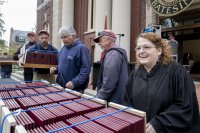
April showers — plus a lot of help from a student work crew during Short Term — make May’s flowers look their best at Bates.
Getting ready for Commencement weekend, Bates landscape architect Bill Bergevin hires students to help with the springtime cleanup: field work, gardening, and laying mulch — 60 cubic yards’ worth — around campus.
Besides getting some extra paid help from his crew of four women and four men, “it’s a great opportunity for me to get to know the students on campus,” Bergevin says.
After digging into rigorous academic courses, workers like Max Millslagle ’17 of Bend, Ore., enjoy digging into the dirt during Short Term.
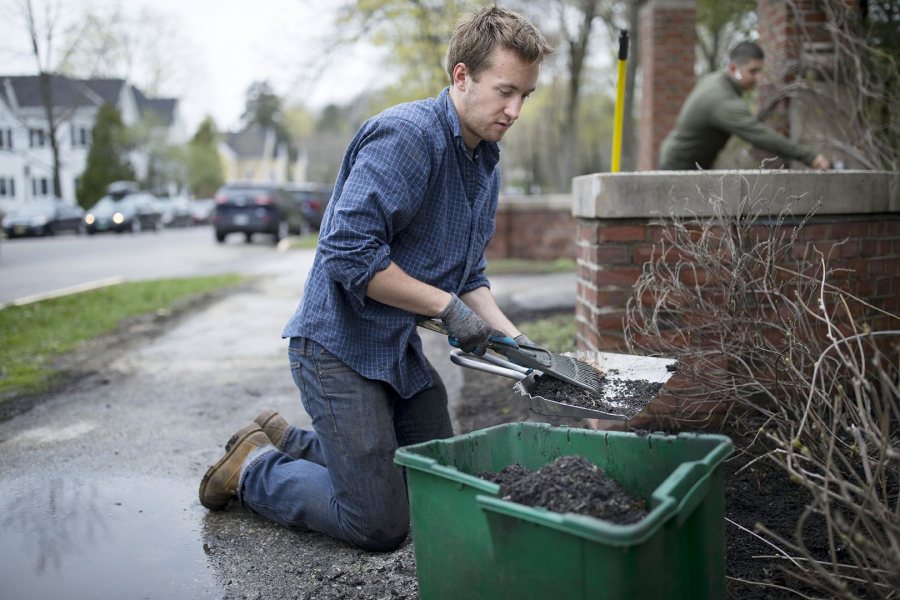
Max Millslagle ’17 of Bend, Ore., works on shrub beds next to the Kenison Gate on Campus Avenue. (Phyllis Graber Jensen/Bates College)
“I definitely notice where we have worked, and it’s always rewarding to see that we are making progress,” says Millslagle, who has done yard work as a summer job. “It’s nice being outside and playing around in some dirt.”
Millslagle isn’t taking a Short Term course this spring (students need to complete just two during their Bates career), so he’s free to focus on this landscaping work, plus having fun with his soon-to-graduate classmates.
Two years younger, Jamie Kelleher ’19 from Redondo Beach, Calif., balances grounds work with fieldwork: Her Short Term anthropology course, “Encountering Community,” involves research in Lewiston-Auburn.
“One of the good things about this job is that there are structured times,” Kelleher explains. “My Short Term is mostly independent research, so this job gives me an opportunity to be outside, meet some new students, and make money at the same time. It also keeps me in very good shape!”
This is Bergevin’s 35th year at Bates. Starting as a member of the Facility Services grounds crew, he has maintained a passion for planting, gardening, and making the campus look its best during prime time, Commencement weekend.
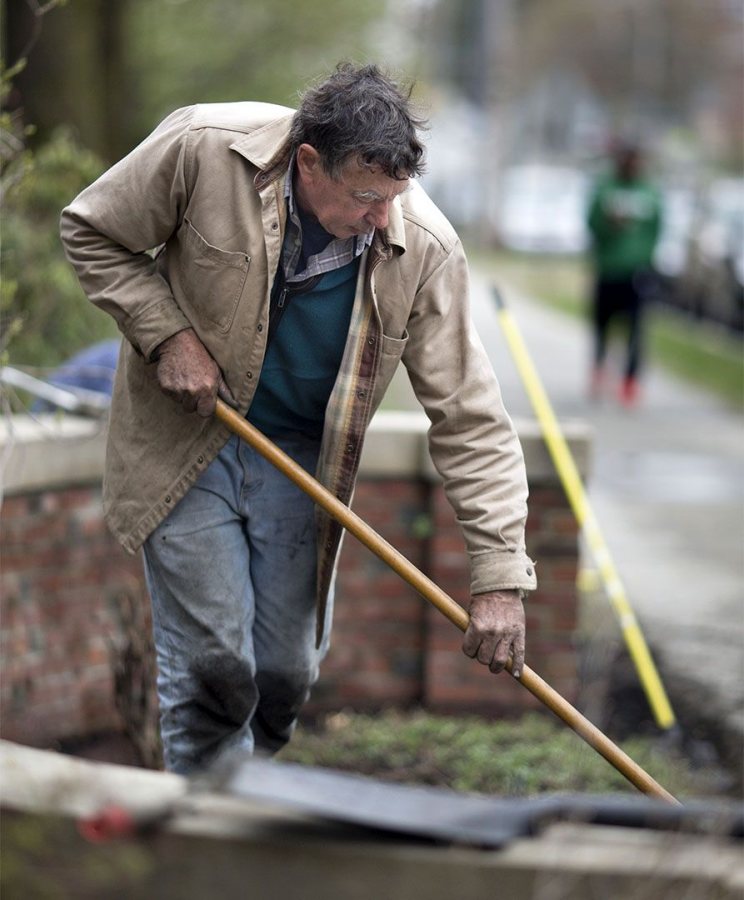
Bill Bergevin sweeps the sidewalk after a mulching session near Carnegie Science Hall. (Phyllis Graber Jensen/Bates College)
“It’s nice, hopefully, at the end of Short Term to take a breath, look at the campus, and feel a little bit of satisfaction that we played a part in how good it looks,” he says. “Because it almost always does look impressive for Commencement.”
“It’s cool to have a part in how campus is going to look when I graduate in a few weeks,” says Clarke Shipley ’17 of Andover, Mass.
In order to get his students squared away and ready to work by 8 a.m., Bergevin starts as early as 6:30 in the morning, rain or shine. He sets out and dries out (as needed) all of his equipment, consisting of several rakes, shovels, mulching forks, hoes, buckets, bins, tarps, dump truck, and a Bobcat skid-steer loader.
A big focus of the work is to clean up the shrub and flower beds, raking and removing leaves left over from the fall cleanup and removing winter debris.
“I try to look at the campus through other people’s eyes and see what I think they see,” Bergevin says. “I try to do everything that I can to make sure that the place looks good for everybody.”
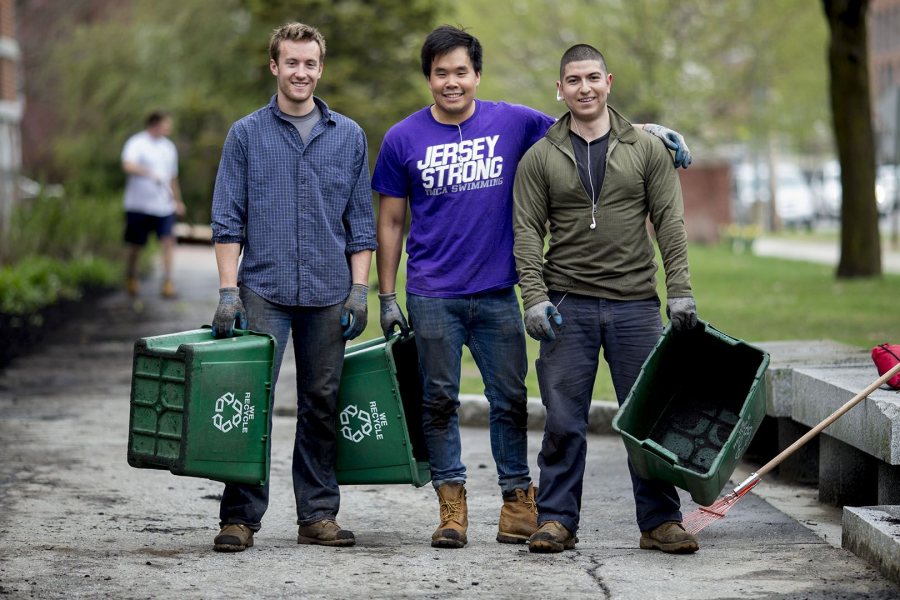
Max Millslagle ’17 of Bend, Ore., JD Chow ’17 of Montclair, N.J., and Diego Marcogliese ’17 of Los Angeles take a brief break from work to pose for a photograph. (Phyllis Graber Jensen/Bates College)
Once all the beds are cleaned up all around campus, Bergevin and his students go through and lay down black mulch, delivered earlier in the spring by a company in nearby Poland.
The 60 yards of mulch is delivered to the Cutten Maintenance Center. Bergevin uses a college dump truck to haul large loads to where he and his students are working — dumping them on a large tarp — then uses the Bobcat to bring smaller loads closer to the beds.
Once all the mulching is done, the next project is to plant annuals and perennials around campus.
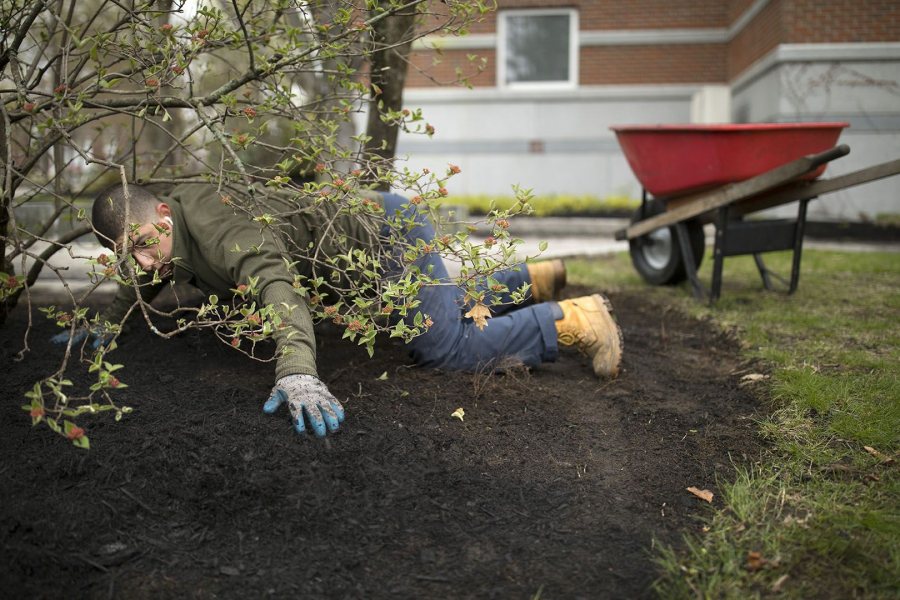
Diego Marcogliese ’17 of Los Angeles stretches himself to spread mulch near Carnegie Science Hall. (Phyllis Graber Jensen/Bates College)
Bergevin grows his own flowers in the campus greenhouse located next to Cutten Maintenance Center. This year, be on the lookout for Bill’s very own begonias and cleomes.
The Historic Quad, Bates’ oasis, is one of Bergevin’s favorite Bates places. As old trees come down, he’s selected and planted more than a few new trees over the years.
“It is rewarding to know that I played a role in how the campus is going to look for the next 50 to 100 years,” says Bergevin, with just a hint of a smile as he works, on his hands and knees, mulching beds near Carnegie Science Building.




